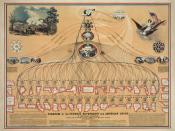AbstractAfter filing an Equal Employment Opportunity Commission (EEOC) complaint and seeing the complaint through to arbitration and then being sent a "Right to Sue" letter, the next step is to file a complaint with the court of jurisdiction. Dependant on what discrimination law the Right to Sue letter is used will depend on what court the complaint will be filed. State or Federal Court systems are two separate and distinct institutions and have different rules of law.
Comparing Differences in State and Federal Court SystemsBeginning an Equal Employment Opportunity Commission (EEOC) complaint is the only formal proceeding that must be satisfied prior to any state or federal civil litigation involving discrimination by an employee against an employer. Black's Law Dictionary defines "Litigation" as a "contest in a court of law for the purpose of enforcing a right or seeking a remedy" (Roth, 2005). When a dispute arises between legal entities and the parties cannot resolve the matter, the Judicial System is the branch of government that all of us have established to resolve the dispute (Roth, 2005).
Normally, when one party believes that a wrong has been perpetrated against them, the civil courts are used for justice. In an EEOC case, the very first and only initial complaint must be to the EEOC itself. No court, state of federal will accept a civil lawsuit involving discrimination without an EEOC investigation and if warranted, an attempt to enter into arbitration with the two parties. After a failed arbitration attempt, if the EEOC believes according to their investigation that the complainant was the subject of discrimination, a "Right-to-Sue" letter is granted within thirty days. At this point, a strategic decision will be required by the complainant in which jurisdiction to file the civil lawsuit. Federal court as a first venue is very...


